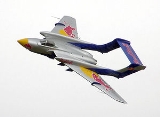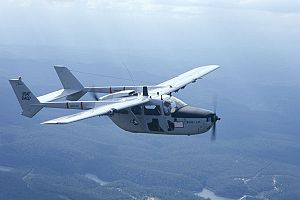
Twin boom
Encyclopedia


Tailplane
A tailplane, also known as horizontal stabilizer , is a small lifting surface located on the tail behind the main lifting surfaces of a fixed-wing aircraft as well as other non-fixed wing aircraft such as helicopters and gyroplanes...
s and vertical stabilizer
Vertical stabilizer
The vertical stabilizers, vertical stabilisers, or fins, of aircraft, missiles or bombs are typically found on the aft end of the fuselage or body, and are intended to reduce aerodynamic side slip. It is analogical to a skeg on boats and ships.On aircraft, vertical stabilizers generally point upwards...
s mounted on the tail of either two fuselage
Fuselage
The fuselage is an aircraft's main body section that holds crew and passengers or cargo. In single-engine aircraft it will usually contain an engine, although in some amphibious aircraft the single engine is mounted on a pylon attached to the fuselage which in turn is used as a floating hull...
s or on two booms fixed to either both sides of the single fuselage, the wing
Wing
A wing is an appendage with a surface that produces lift for flight or propulsion through the atmosphere, or through another gaseous or liquid fluid...
s or the engine
Engine
An engine or motor is a machine designed to convert energy into useful mechanical motion. Heat engines, including internal combustion engines and external combustion engines burn a fuel to create heat which is then used to create motion...
nacelle
Nacelle
The nacelle is a cover housing that holds engines, fuel, or equipment on an aircraft. In some cases—for instance in the typical "Farman" type "pusher" aircraft, or the World War II-era P-38 Lightning—an aircraft's cockpit may also be housed in a nacelle, which essentially fills the...
s.
The reason for this design choice may be:
- To be able to place a cargo door in the back of the aircraft (examples include the C-82 PacketC-82 PacketThe C-82 Packet was a twin-engine, twin-boom cargo aircraft designed and built by Fairchild Aircraft. It was used briefly by the United States Army Air Forces and United States Navy following World War II.-Design and development:...
and C-119 Flying BoxcarC-119 Flying BoxcarThe Fairchild C-119 Flying Boxcar was an American military transport aircraft developed from the World War II-era Fairchild C-82 Packet, designed to carry cargo, personnel, litter patients, and mechanized equipment, and to drop cargo and troops by parachute...
) - To construct propellerPropeller (aircraft)Aircraft propellers or airscrews convert rotary motion from piston engines or turboprops to provide propulsive force. They may be fixed or variable pitch. Early aircraft propellers were carved by hand from solid or laminated wood with later propellers being constructed from metal...
aircraft in pusher configurationPusher configurationIn a craft with a pusher configuration the propeller are mounted behind their respective engine. According to Bill Gunston, a "pusher propeller" is one mounted behind engine so that drive shaft is in compression...
or jet aircraftJet aircraftA jet aircraft is an aircraft propelled by jet engines. Jet aircraft generally fly much faster than propeller-powered aircraft and at higher altitudes – as high as . At these altitudes, jet engines achieve maximum efficiency over long distances. The engines in propeller-powered aircraft...
with the engine mounted directly to the aft of the fuselage (Bell XP-52Bell XP-52|-External links:*...
, De Havilland VampireDe Havilland VampireThe de Havilland DH.100 Vampire was a British jet-engine fighter commissioned by the Royal Air Force during the Second World War. Following the Gloster Meteor, it was the second jet fighter to enter service with the RAF. Although it arrived too late to see combat during the war, the Vampire served...
, Saab 21Saab 21|-See also:-References:NotesBibliography* Billing, Peter. "A Fork-Tailed Swede." Air Enthusiast Twenty-two, August–November 1983. Bromley, Kent, UK: Pilot Press Ltd., 1983....
) - For unobstructed field of view or field of fire to the rear (Focke-Wulf Fw 189Focke-Wulf Fw 189|-See also:-References:NotesBibliography* Brown, Capt. Eric . Wings of the Luftwaffe. Garden City, NY: Doubleday & Company, Inc., 1978. ISBN 0-385-13521-1....
) - Twin aircraft, constructed by putting two copies of an existing traditional aircraft side-by-side, (P-82 Twin Mustang, Messerschmitt Me 609)
- To accommodate early inline engines and their lengthy turbochargers in the most aerodynamically efficient/practical planform (P-38 LightningP-38 LightningThe Lockheed P-38 Lightning was a World War II American fighter aircraft built by Lockheed. Developed to a United States Army Air Corps requirement, the P-38 had distinctive twin booms and a single, central nacelle containing the cockpit and armament...
) & (P-61 Black WidowP-61 Black WidowThe Northrop P-61 Black Widow was the first operational U.S. military aircraft designed specifically for night interception of aircraft, and was the first aircraft specifically designed to use radar. It was an all-metal, twin-engine, twin-boom design developed during World War II...
) - To increase an aircraft structure's rigidity, strength, and internal volume (Rutan Voyager, Scaled CompositesScaled CompositesScaled Composites is an aerospace company founded by Burt Rutan and currently owned by Northrop Grumman that is located at the Mojave Spaceport, Mojave, California, United States...
Grizzly, Virgin Atlantic GlobalFlyerVirgin Atlantic GlobalFlyerThe Scaled Composites Model 311 Virgin Atlantic GlobalFlyer is an aircraft designed by Burt Rutan in which Steve Fossett flew a solo nonstop airplane flight around the world in a time of 67 hours 1 minute from February 28, 2005 until March 3, 2005...
, Transavia PL-12 AirtrukTransavia PL-12 Airtruk-Bibliography:*Donald, David . The Encyclopedia of World Aircraft. Leicester, UK: Blitz, 1997. ISBN 1-85605-375-X.*Taylor, John W R. . Jane's All the Worlds Aircraft 1976-77. London:Jane's Yearbooks, 1976. ISBN 0 354 00538 3....
) - To provide for room to carry external cargo, such as Scaled Composites WhiteKnightTwo. Burt Rutan refers to this design concept as "open architecture".
Other examples of twin boom aircraft:
- Adam A700
- Adam A500Adam A500The Adam A500 is a six-seat civil utility aircraft that was produced by Adam Aircraft Industries. The aircraft is of pod-and-boom, push-pull configuration with its two Continental TSIO-550-E piston engines mounted to provide centerline thrust....
- Blohm & Voss BV 138
- Cessna SkymasterCessna SkymasterThe Cessna Skymaster is a United States twin-engine civil utility aircraft built in a push-pull configuration. Its engines are mounted in the nose and rear of its pod-style fuselage. Twin booms extend aft of the wings to the vertical stabilizers, with the rear engine between them. The horizontal...
/O-2 SkymasterO-2 SkymasterThe O-2 Skymaster is a military version of the Cessna 337 Super Skymaster utilized as an observation and forward air control aircraft... - De Havilland Sea VixenDe Havilland Sea VixenThe de Havilland DH.110 Sea Vixen was a twin boom 1950s–1960s British two-seat jet fighter of the Fleet Air Arm designed by de Havilland. Developed from an earlier first generation jet fighter, the Sea Vixen was a capable carrier-based fleet defence fighter that served into the 1970s...
- De Havilland VenomDe Havilland VenomThe de Havilland DH 112 Venom was a British postwar single-engined jet aircraft developed from the de Havilland Vampire. It served with the Royal Air Force as a single-seat fighter-bomber and two-seat night fighter....
- Fokker F.25Fokker F.25|-References:*...
- Fokker G.IFokker G.IThe Fokker G.I was a Dutch heavy twin-engined fighter plane comparable in size and role to the German Messerschmitt Bf 110 and the British Mosquito. Although in production prior to World War II, its combat introduction came at a time when the Netherlands was overrun...
- Heinkel He 111Z Zwilling
- Hughes XF-11
- Messerschmitt Me 409
- Nord NoratlasNord NoratlasThe Nord Noratlas was a 1950s French military transport aircraft intended to replace the older types in service at the end of World War II. Several hundred were produced in a run lasting over a decade, finding a wide variety of uses.-Development:...
- North American Rockwell OV-10 BroncoOV-10 BroncoThe North American Aviation Rockwell OV-10 Bronco is a turboprop light attack and observation aircraft. It was developed in the 1960s as a special aircraft for counter-insurgency combat, and one of its primary missions was as a forward air control aircraft...
- PZL M-15 Belphegor
- Sadler VampireSadler Vampire|-Specifications :-External links:* * * *...
- Scaled Composites White Knight
- SIPA S-200 MinijetSIPA S-200 Minijet-References:NotesBibliography...
- Sukhoi Su-12Sukhoi Su-12|-See also:-References:*Antonov,Vladimir & Gordon, Yefim & others. OKB Sukhoi”. Leicester. Midland. 1996. ISBN 1 85780 0125...
- Sukhoi Su-80
- Schweizer RU-38 Twin CondorRU-38 Twin CondorThe Schweizer RU-38 Twin Condor is a two or three-seat, fixed gear, low wing, twin boom covert reconnaissance aircraft.RU-38 is the US military designation for the aircraft, indicating Utility, Reconnaissance...
- US Army RQ-7 ShadowRQ-7 ShadowThe RQ-7 Shadow unmanned aerial vehicle is used by the United States Army and Marine Corps. Launched from a trailer-mounted pneumatic catapult, it is recovered with the aid of arresting gear similar to jets on an aircraft carrier...

